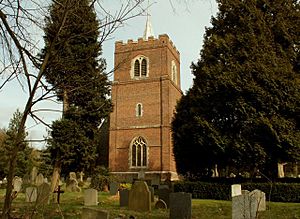St Mary the Virgin's Church, Stansted Mountfitchet facts for kids
Quick facts for kids St Mary the Virgin's Church,Stansted Mountfitchet |
|
|---|---|

Tower of St Mary the Virgin's Church, Stansted Mountfitchet
|
|
| Lua error in Module:Location_map at line 420: attempt to index field 'wikibase' (a nil value). | |
| OS grid reference | TL 521 242 |
| Location | Stansted Mountfitchet, Essex |
| Country | England |
| Denomination | Anglican |
| Website | Churches Conservation Trust |
| History | |
| Dedication | Saint Mary the Virgin |
| Architecture | |
| Functional status | Redundant |
| Heritage designation | Grade II* |
| Designated | 21 February 1967 |
| Architect(s) | Francis T. Dollman (restoration) |
| Architectural type | Church |
| Style | Norman, Gothic |
| Specifications | |
| Materials | Flint and stone, brick tower |
St Mary the Virgin's Church is an old Anglican church located near the village of Stansted Mountfitchet in Essex, England. It is no longer used for regular church services, which is why it's called a "redundant" church. This special building is looked after by the Churches Conservation Trust.
The church is listed as a Grade II* building on the National Heritage List for England. This means it's a very important historical building. You can find it about 1 kilometer (or 1 mile) southeast of the village, within the grounds of Stansted Hall. It's considered important because of its long history and interesting features inside.
Contents
History of the Church
The church was built a very long time ago, between 1120 and 1124. It was built by a person named William Mountfitchet. Some parts of the church from that original time are still there today.
In the 1200s, the chancel (the part of the church where the altar is) was made longer towards the east. A small chapel was also added to the north side of the church. The tall west tower was built much later, in 1692.
The church had a big makeover in 1888 by an architect named Francis T. Dollman. During this time, the nave (the main part of the church where people sit) and the aisle (the walkway) were rebuilt.
A new church, called a chapel of ease, was built closer to the village in 1889. This new church was dedicated to Saint John the Evangelist. Today, this newer church is the main parish church for Stansted Mountfitchet. St Mary's Church is still considered a holy place and is sometimes used for special services or other events.
Church Design and Features
St Mary's Church is built using flint and stone. The tower, however, is made of brick. Some parts of the original 12th-century building are still visible. These include the arch leading to the chancel and the doorways on the north and south sides. These parts show the Norman style.
The chancel arch has cool decorations like zigzag patterns and carvings that look like ball flowers. The doorways are similar, with columns that have unique scalloped tops called capitals. They also have X-shaped saltire decorations. The space above each doorway, called the tympanum, is decorated with a pattern of small squares, known as diapering.
Inside the Church
The font, where baptisms take place, is from the 1200s. Its special ogee-shaped cover was added in the 1600s. The communion rail, which separates the altar area, is from the 1700s.
You can also see some interesting monuments inside. One is a stone statue of a knight in armor lying down. His legs are crossed. People believe this statue is a memorial to Roger de Lancaster, who passed away in 1310.
Other important monuments are from the 1600s. One is for Sir Thomas Middleton. It shows a statue of him lying on a stone coffin, called a sarcophagus. This is under an arch supported by black marble columns with fancy Corinthian tops. Another monument is an altar tomb for Hester Middleton, who died in 1614. It also has a statue of her lying on a sarcophagus. Hester was either Sir Thomas's wife or his daughter.
Outside the Church
The churchyard, which is the area around the church, has war graves. These are the burial places for five service members from World War I and four from World War II.
Tower and Bells
The brick tower of the church holds a set of eight bells. These bells were made by different founders. What's really special about these bells is how they are hung and rung. They are set up to be rung in an anti-clockwise direction. This is quite rare, as most other bell towers have their bells arranged to be rung clockwise. The largest of the eight bells weighs about 13 hundredweight (which is about 660 kilograms or 1,456 pounds).
Even though the church is no longer used for regular services, these bells are still rung often. The North-Western district of the "Essex Association of Change Ringers" organizes a monthly practice session. This usually happens on the second Friday of every month, starting at 7:45 PM. However, they don't have practices in April or August because of a regional ringing school and summer holidays.
See also

